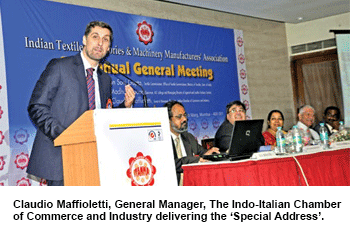
Collaborate or innovate to make New India
I think the main difference between we Indians and outsiders are that we need to be more receptive to new technology, we should not fear of trial and errors on experimentation.
´I think the main difference between we Indians and outsiders are that we need to be more receptive to new technology, we should not fear of trial and errors on experimentation. We need to do more research and it is only through innovation on new things I think new India can emerge´: It was a clarion call from the Textile Commissioner, Kiran Soni Gupta, made at the recently held 71st Annual General Meeting of the Indian Textile Accessories & Machinery Manufacturers´ Association (ITAMMA) in Mumbai.
She said: ´The ´Make in India´ project inaugurated by Prime Minister Narendra Modi is truly the need of the hour. No doubt India has progressed a lot, but a very important component of growth as I have said earlier – is technology. It has to do with machines, with the way we work, with the instruments that we work and technology alone is not enough. I feel it is the diffusion and adoption of technology which is much more important. Therefore, it is very important that we bring in the best of engineers, best of manufacturers and the best of users so that we get the best product that we are looking at.´
´While sanctioning the ´Technology Upgradation Fund Scheme (TUFS)´, the prime focus of has been on modernisation of textile industry. In TUFS, the scheme which has been going on since 1999, has catalysed an investment worth Rs 2,60,000 crore. That is the value which has been created largely by the machines that we have put together and which has accounted for the growth of industry,´ the Textile Commissioner said..
Kiran Gupta said: ´The whole tug of war between the countries amongst the countries is of technology. But I feel India needs to focus if manufacturing, which has to become a base of a growth, a key for a growth. We need to be more innovative, we need to spend more budgets on research & development, we need to evolve a better model every day, it is not just one time effort.´.
Earlier, in his presidential speech Diven Dembla, President, ITAMMA, gave an account of the status of the textile engineering industry. He said that ´the Textile Industry has been badly affected, as demand on account of high inflation has not grown as expected. However, with the change in the political landscape, there has been a resurgent optimism in the Indian economy.´
Dembla said: ´The Indian textile engineering industry, collectively has a production capacity of about Rs 9,000 crore, with a capacity utilisation of about 55-60 per cent. The total estimated requirement from our customer industry is approximately Rs 14,000 crore, whereby nearly 55 per cent of this demand is met through imports. Out of the huge imports of textile machinery and components aggregating to around Rs 9,000 crore, more than 20 per cent of the same, is in the form of used and pre-owned machines.´
Talking about ITAMMA, he said that ´the association has taken steps in approaching the government through various representations, for withdrawing subsidies under TUF for the installation of pre-owned imported machines of outdated technology, and discouraging imported machines beyond 10 years old. Further more, realising the strength of the Indian textile engineering industry, ITAMMA has prepared a mission plan, with a vision, ´To make India the hub of textile machinery and accessories by 2020.´.
ITAMMA has realised, that henceforth we need to play a role of a proactive partner, rather than only as a facilitator, and ensure that there is an active involvement of the suppliers and users in all our activities.´.
ITAMMA chief also enumerated all the activities of the association including the seminars, product catalogue shows and other events organised during the last year. In his speech, Claudio Maffioletti, General Manager, The Indo-Italian Chamber of Commerce and Industry, gave an account of the specific focus of trade between In




